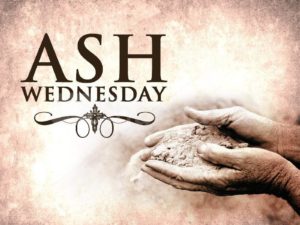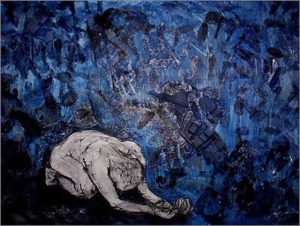[Greek] σποδός (spodos), [Latin] cinis, [French] cendre, [German] asche: ashes, dust, residue from burning; Mt.11:21, Lk.10:13, Heb.9:13

Background Information:
Old Testament: The Old Testament provides the background for the Jewish practice of using ashes, repenting, and fasting. Gen.3:19 reminds us of our mortality as we will become dust. Job. 42:6 shows that dust and ashes represent mortality and repentance before God. Dan.9:3 shows that prayers and intercessions are accomplished through fasting, sackcloths, and ashes. 1Macc. 3:47 illustrates the practice of placing ashes on the forehead. Joel 2:2-18 shows a public day of fasting. Esther 4:12-13 shows Queen Esther putting on a garment of distress and being covered with ashes and dirt in order to repent for her people.
Scripture:
“For you are dust, and to dust you shall return.” Gen. 3:19
This is stark reminder that we all are mortal.

Job stands before God
“Therefore I disown what I have said, and repent in dust and ashes.” Job.42:6
Job stands before God in repentance. The dust and ashes represent mortality and repentance.

The people fasted and sprinkled ashes on their heads
“That day they fasted and wore sackcloth, they sprinkled ashes on their heads and tore their clothes.” 1 Macc.3:47
This scripture passage helps to provide some insight and support for the penitential practice of placing ashes on the forehead.

Daniel, in sackcloth, prays for his people
“I turned to the Lord God, pleading in earnest prayer, with fasting, sackcloth, and ashes.” Dan. 9:3
In repentance Daniel is pleading for his people.

Queen Esther, covered in dirt and ashes, prays for her people
“Queen Esther, seized with mortal anguish, likewise had recourse to the Lord. Taking off her splendid garments she put on garments of distress and mourning. In place of her precious ointments, she covered her head with dirt and ashes. She afflicted her body severely; all her festive adornments were put aside, and her hair was wholly disheveled.” Esther 4:12-13
Queen Esther prays and repents for her people

Called together in prayer and fasting
“Yet even now says the Lord, return to me with your whole heart, with fasting, and weeping, and mourning…..Offerings and libation for the Lord, your God. Blow the trumpet in Zion! Proclaim a fast, call an assembly.” Joel 2:12-18
This calls to mind the Old Testament practice of a public day of fasting. This provides the background for the current practice of receiving ashes on Ash Wednesday.
“Woe to you, Chorazin! Woe to you, Bethsaida! For if the mighty deeds done in your midst had been done in Tyre and Sidon, they would long ago repented in sackcloth and ashes.” Mt.11:21
The Jewish people would have already been aware of the practice of repentance, fasting, and ashes. Jesus was chastising these evil pagan cities of Tyre and Sidon for their wicked ways.
New Testament: On the Sermon of the Mount, Jesus tells others that performing righteous deeds, giving alms, and fasting must be done in secret.
Mt.6:1: Do not perform righteous deeds in order that others may see them
Mt.6:2: Do not give alms to win the praises of others
Mt.6:4: Give your alms in secret so that the Father who sees in secret will repay you
Mt.6:5: Do not pray in order that others may see you
Mt.6:6 Pray in secret so that the Father who sees in secret will repay you
Mt.6:16: When fasting, do not look gloomy like the hypocrites
Mt.6:17: When you fast, anoint your head and wash your face so that you may appear to others not to be fasting.
Conclusion:
Cinder, ash
It is important to note that 1Macc.3:47, a Catholic Old Testament book not recognized by Protestants, makes reference to putting ashes on their heads.
Yet, Catholics, Christians, Protestants, and even Jews attend Ash Wednesday services. (This is a perfect reminder, despite one’s faith affiliation, that we will all become like dust in our mortality.)
Ash Wednesday: the public aspect of Lent.
Remaining days of Lent: the private penitential aspect of Lent.
For all of you like me, I am sure you may have friends who are wondering why we do these things at Lent. So let them know why you have a strange mark on your forehead. What better way to be a witness to others!
